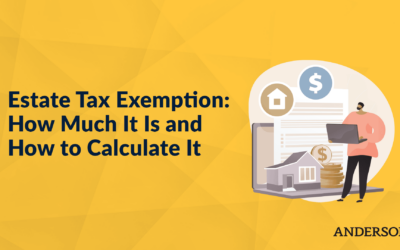Updated Jan 2023
There are many ways to reduce your end-of-year liabilities for 2022. Starting your tax planning immediately is the best way to take advantage of these new opportunities. As the tax year comes to a close, here are some tax strategies to consider for reducing your liabilities and saving money. Don’t forget about Retirement Tax Planning – Learn more here.
6 Tax Planning Strategies to Reduce Your Taxes
- Lower Taxable Income
- Take Advantage of Deductions
- Utilize Tax Credits
- Gifts and Estate Planning
- Restructure Portfolio or Businesses
- Review Other Key Tax Issues
Who Is Tax Planning For?
Tax planning services can be helpful for almost everyone. Business owners, investors, and freelancers should especially consider seeking advice from a professional. Those who earn any income that is not taxed through an employer– such as dividends, capital gains, and rent– are responsible for paying their own taxes. Those who are self-employed must pay Social Security and Medicare taxes, as well as state taxes. In many cases, these taxes will be due quarterly through estimated taxes. Paying too little in taxes each quarter can result in heavy underpayment penalties and other issues.
In addition to these more complex requirements, business owners, freelancers, and investors can also take advantage of complex tax benefits, such as the new 20% deduction for pass-through businesses and bonus depreciation allowance. Tax law has been greatly changed by the recently introduced tax reform. If you want to get the best tax result possible, it’s highly recommended that you consult with a tax professional or a tax lawyer. A tax advisor can help you plan to minimize your year-end tax liability and retain more of your hard-earned money. Consider the following strategies:
Lower Taxable Income
One of the most important strategies for taxpayers is to lower taxable income through a variety of methods. This can be as simple as deferring a payment or invoice to the next tax year or making payments early to capitalize on related tax benefits (be sure to read our article on capital gains strategies for real estate flippers). When using these methods, it is important to consider the tax implications of the following tax year as well. For example, business owners could wait to send out invoices until the end of the year, so payments will be received the following year.
In contrast, credit cards could be used to capture payments in the current year that will be paid off in the following year. In a similar way, one could use mailing a check to delay a payment until the next year. Before utilizing such a method, carefully consider the tax implications. These methods might move you to a higher or lower tax bracket for one year at the expense of the next year.
Loss Harvesting
You can also offset capital gains through a variety of methods. Taxpayers considering selling investments that have increased in value can use loss harvesting to offset gains in a given year. If more losses are realized than gains, the excess can be used to write off up to $3,000 of regular income for single filers and $1,500 for those who are married and filing separately. Any amount over that can be carried over into future years as well.
There are a couple important things to consider with this technique. A security that is sold at a loss cannot be invested in again for at least 30 days leading up to and following the sale– or the IRS “wash rule” will invalidate the write-off. Investing in significantly similar securities may also trigger this rule. Ensure this method will work for your investments you want to use it on by checking with a tax compliance professional. Real property investors can also use the Section 1031 like-kind exchange to roll over capital gains into a similar property type and defer the taxes on the gains until a later date.
401(k) and 403(b) Retirement Accounts
Another option is to contribute to tax-advantaged accounts, such as employer-sponsored retirement accounts. If you are employed, you should check into available 401(k) or 403(b) programs. In some cases, employers will match your contributions which are taken from paychecks before taxes. This allows for powerful tax-free growth along with the extra contribution from your employer. There are contribution limits for these accounts which are adjusted for inflation, such as $18,500 for 2018, but with an optional “catch-up” contribution for those over 50 of an additional $6,000 annually. Exceeding those contribution limits can result in taxes on the overage amounts.
Traditional and Roth IRA
Besides employer-sponsored retirement accounts, taxpayers should consider both traditional and Roth individual retirement accounts (IRA). Traditional IRAs allow for tax-deductible contributions based on the year you make them, on the premise that you may be in a lower tax bracket when you retire. In contrast, a Roth IRA offers no tax breaks when contributing in a given year but earnings and withdrawals are tax-free. An important point for both IRAs is that money can be added up until the due date for annual tax returns in April, allowing you to make last minute contributions. However, the tax advantage is limited to annual contributions of $5,500 for those under 50, and up to $6,500 for those over 50. It is also possible to roll a traditional IRA into a Roth IRA subject to tax, but recent changes do not allow these to be re-characterized– so plan carefully.
529 Plans and HSAs
For those looking to further reduce taxable income, it may be worthwhile to consider investing in a Health Savings Account (HSA). Health Savings Accounts offer many benefits similar to 529 plans if used for eligible health costs. Some employers that offer HSAs may also offer matching contributions, making this option even more attractive. Interest, dividends, and capital gains are not taxed in the account and are not taxed if used on eligible healthcare costs. Additionally, an HSA balance can also be carried over to the next year.
HSAs are subject to contribution limits of $3,450 for individuals under 55 and $6,850 for family accounts. Those over 55 can contribute an additional $1,000. Unfortunately, a downside to these accounts is that you must also have a high deductible health plan to qualify for an HSA. This means deductibles of at least $1,350 for individuals and $2,700 for family plans. Additionally, there are other restrictions you need to consider, which is why it is recommended that you consult with a tax advisor.
Under the Tax Cuts and Jobs Act (TCJA, the tax code), 529 Education Plans have increased advantages over previous years, including an expansion of eligible uses. While contributions use post-tax funds, some states offer tax deductions for these accounts. Besides using these plans for higher education costs, up to $10,000 per year can also be used for elementary or secondary, religious or private schools. If used for eligible purchases, gains earned in these accounts can be tax free at both federal and state levels. Contributions are set by individual states but can also be limited by the gift tax of $15,000 to reap the best tax benefits.
Take Advantage of Deductions
The Tax Cuts and Jobs Act (TCJA) has made sweeping changes, including some lower tax brackets, new tax deductions, and the reduction or removal of some itemized deductions and exemptions. As a result of this act, many more taxpayers will seek the increased standard deduction than in previous years. The standard deduction has increased to $12,000 for individuals and $24,000 for married joint filers. The TCJA eliminated or decreased the effectiveness of some itemized deductions, such as tax preparation fees, employee business expenses, personal exemptions, and home equity debt interest unless used to substantially improve the home (subject to limitations).
Another major change is the limit in the SALT deduction (state and local tax deductions) to $10,000. This change especially impacts those in high-tax states where residents are considering drastic options, such as moving to low tax states. Because of this major federal tax change, many of these high-tax states are also considering changes to their tax laws to compensate.
Charitable Donations and Bunching
The benefit of making charitable donations increased with the TCJA because eligible amounts were increased to 60% of AGI. This method has allowed taxpayers who itemize to donate assets to a worthy cause, as well as to reduce taxes with deductions. While the increased standard deduction has decreased the value of itemizing in other ways, it is still possible to benefit from this provision. Using a method called bunching, charitable contributions and other itemized deductions are pooled or “bunched” into one year to obtain a greater overall deduction, and the taxpayer can utilize the standard deduction in alternating years. In order to retain control over the contributions, one could consider creating a donor-advised fund or foundation that makes payouts over future years while allowing claimable deductions in a desired year.
20% Deduction for Pass-Through Businesses
One of the most anticipated deductions of the TCJA is Section 199A– the new 20% deduction for eligible pass-through businesses such as those under an LLC operating agreement (LLCs) sole proprietors, partnerships, and S-Corps. This deduction is also available for some real estate professionals and those who earn dividends from Real Estate Investment Trusts (REITs). Professional real estate tax planning help may be very helpful in navigating these changes in deductions.
The Section 199A deduction can be taken on each source of qualified business income (QBI) for a taxpayer, such as those with multiple pass-through businesses– although there are income and other limitations. Some business types are excluded from the deduction at higher gross income levels, but almost every trade or business is eligible for taxpayers with income below $157,500 for single filers and $315,000 for joint filers.
Those with income higher than the lower threshold, but below $207,500 for single filers and $415,000 for joint filers, may still be eligible for a phased-out version of the deduction even if they earn income from excluded businesses. However, over those higher thresholds, additional limits apply such as the greater option of either 50% of W-2 wages or 25% of W-2 wages plus 2.5% of the unadjusted basis for qualified property. Real estate investors are greatly impacted by this final provision. For more information on the taxes that apply to your real estate investments, be sure to read our guide on real estate taxes.
It is essential to note that this deduction can’t be claimed for a business operating in a loss that year. Some freelancers may be able to claim this deduction as sole proprietors. Also, those who work from home may also be able to deduct the cost of running their home office.
Depreciation
Under the TCJA, the benefits of deducting depreciation for property was increased. First, the definition of Section 179 property was expanded and can include real property, such as computers and HVAC equipment. The maximum deduction was doubled from $500,000 to $1,000,000 with a phase-out threshold up to $2,500,000.
To be eligible, the property can be new or used but must be purchased and placed into service in that year you claim the deduction. Another key point is that the entire amount of depreciation can be claimed in this first year instead of spreading it out over several years. Also, qualified property can be eligible for a 100% bonus depreciation deduction, such as heavy vehicles. However, these deductions are set to be phased out over the next few years and various states may decide on different depreciation rules in the coming months. Consult with a tax professional to ensure you qualify for these and other deductions, and to determine the correct amount of the deduction in your specific circumstance.
Utilize Tax Credits
Taxpayers can take advantage of many tax credits. Deductions reduce taxable income, while on the other hand, credits directly reduce the amount of tax due. Besides the credits regularly available, it is worthwhile to consider taxes that are set to expire in coming years, such as the Investment Tax Credit. For example, this covers up to 30% of installation costs for eligible solar energy systems. Many states also offer comparable tax credits, subject to limitations.
The TCJA also expanded some tax credits like the Child Tax Credit. This credit was increased to $2,000 per child and is refundable up to a maximum $1,400 per child, depending on income, and is capped at 15% of earned income in excess of $4,500. Threshold limits start at a maximum AGI of $200,000 and phase out up to $240,000 for single filers and $400,000 to $440,000 for joint filers. Those taxpayers in the phase-out amounts can receive a partial credit that decreased by $50 for every $1,000 of AGI. This credit is refundable—if the taxpayer liability is decreased to zero, then any amount of credit over will result in a refund.
In addition to the Child Tax Credit for qualified children under 17, there is also a nonrefundable credit of $500 for dependents over 17 (which includes caring for aging parents). This credit is offset by the elimination of personal exemptions and dependent exemption but should still benefit many taxpayers. There are many other credits to consider as well. Consider consulting with a tax compliance advisor to see which credits you are eligible to receive.
Gifts, Estate, and Succession Planning
Another key component of income tax planning is considering how to structure your estate. Planning on how to handle your assets in the case of death (such as succession planning) is not a generally pleasant thought, but preparing for this now can save your family members and beneficiaries from future legal battles and heartache. The TCJA also offers temporary benefits such as greatly increased estate tax exemptions of $11 million for individuals and $22 million for married joint filers.
The estate tax exemption is tied to the gift tax exemption, which is why it may be beneficial to consider these two together. The annual gift tax exclusion amount is now $15,000, which can be given to as many individual people as you desire. Any amount over that must be reported to the IRS and will start to decrease the lifetime gift tax exemption of the giver, which will also reduce the total amount of the estate tax exemption. Some transfers are not considered gifts and will not deduct from the lifetime limits, such as those given to U.S. citizen spouses, dependents, charitable donations and political contributions. Also, qualified payments made on behalf of someone else directly to health care and education institutions are excluded. Finally, if a spouse is not a U.S. citizen there is an excluded amount up to $152,000 per year before it reduces the lifetime amounts.
Amounts that exceed the lifetime limits are subject to much higher tax rates up to 40%. Setting up trusts to manage larger estate assets, such as revocable living trusts or a dynasty trust, can be an effective way to combat these higher taxes. For taxpayers that may want to pass a business on to the next generation, it may be a good idea to consider grantor retained annuity trusts (GRATs). The greatly increased lifetime estate tax exemption is scheduled to revert to 2017 levels in 2026, which is why now is a great time to start estate planning (watch out for these commonly made estate planning mistakes). Because estate and gift exemptions are tied together, it is important to carefully consider how to distribute your assets.
Kiddie Tax
In tandem with the gift tax, it is important to note another related tax called the Kiddie tax, which taxes unearned income held by dependents under 24 years old. This can include income other than wages and salaries, such as capital gains, interest, and dividends from held investments. While earned income is not subject to this tax, it can be used to calculate the Kiddie tax standard deduction– which for 2018 is $1,050, or earned income plus $350, not to exceed $14,000. This tax may not apply to students aged 19-23 but will apply to students up to 18 years old. When considering end-of-year aggressive tax planning and gifting to children, carefully consider whether the Kiddie tax might reduce the benefit of such a strategy.
Restructure Your Portfolio or Business
Another strategy to consider as the end of the year approaches is restructuring your portfolio to take advantage of tax-efficient investment vehicles. Gains for investments held for more than a year are generally taxed more favorably than short-term gains. Moving investments to achieve a desired tax benefit requires careful consideration and would best be done with the advice of a qualified tax professional. For more information, consider these top tax-free investments.
In tandem with this option is the idea of restructuring a business in order to claim the best deductions and credits. For example, corporations have received a permanent tax reduction from 35% to 21% under the TCJA, which also eliminated the Alternative Minimum Tax (AMT) for those companies. In contrast, deductions for pass-through businesses are set to be phased out over the next few years. It may be worth converting independent contractors to employees to gain more W-2 wages for the 20% deduction. However, this also includes associated payroll taxes and other employee costs. Before making such a drastic change, check with a tax advisor regarding the advantages and disadvantages of such a move. Considering this option in the early stages of your tax planning is best to allow you to make changes before the December 31st deadline.
Other Important Tax Issues
There are many other key end-of-the-year tax issues to consider. For example, the Alternative Minimum Tax (AMT) is not reduced by some deductions and may be triggered by certain events. If the AMT is higher than the tax rate achieved through normal methods, the higher amount must be paid– which could negate the benefit of many of these strategies. The TCJA did increase the exemption amount of the AMT to $70,300 for individuals and $109,400 for married joint filers. The phase-out threshold was also increased to $500,000 and $1,000,000, respectively. The AMT has two tax rates of 26% and 28%.
Quarterly Estimated Taxes
Another tax issue to consider is estimated taxes. Taxpayers who earn income must pay taxes on that income as it is earned. If that income is earned through businesses, dividends, rent, and other untaxed methods, it may require paying taxes to the IRS quarterly through estimated taxes. Failing to pay the correct amount quarterly can result in underpayment penalties and other issues. Generally, those who earn less than $400 may not need to report that income. However, those with a tax liability over $1,000 may have to pay quarterly. Consult with a tax professional if you are unsure if this applies to you.
Avoiding quarterly payments is possible if the taxpayer also works for an employer. Filling out a new W-4 with the employer to increase the income tax withheld from a paycheck can offset the taxes required from the other income sources.
Disaster Relief
The past few years have seen many disasters hit the U.S., which greatly impacts many taxpayers and businesses. For those severely impacted by these disasters, there are tax benefits that you may be eligible to receive in order to help get you and your family back on your feet. The IRS offers options such as additional time to make quarterly payments, file returns, and other time-sensitive acts, as well as possibly waiving penalties associated with not meeting these deadlines. Some benefits are restricted to presidentially declared disaster areas. To find out more, consult with a tax professional.
Anderson Advisors Tax Planning Services
Considering the complicated nature of taxes, as well as the impact of the Tax Cuts and Jobs Act on the various planning options, it is clear that a tax professional could be very helpful with your end-of-the-year planning. Many deductions and credits carry limits and exceptions that may disqualify certain taxpayers, while other options that could save you money and help you reach your financial goals are left unused. Additionally, many tax planning activities, such as estate planning, can result in legal battles and heavy taxes applied to hard-earned gains originally destined for beneficiaries. For additional legal advice, be sure to read our article on Real Estate Asset Management. Careful financial planning will ensure that you receive the maximum reduction in tax liability allowed by law, avoid tax consequences and collect the highest possible tax return. There is no better option than consulting with a tax lawyer to discuss your particular tax situation.
The end of the year is approaching fast! Now is the best time to start your tax planning. As the tax season approaches, the demand for qualified tax lawyers will only increase. In addition, some strategies will become less effective or will be eliminated as tax deadlines approach.
Bonus Video
Free Strategy Session with an Anderson Advisor
Receive a detailed risk assessment to assist in lowering problem areas that could wipe out all of your assets with one wrong move. Speak with an Anderson Professional Advisor to get your FREE Strategy Session.
Limited-Time Offer: ($750 value.)



















